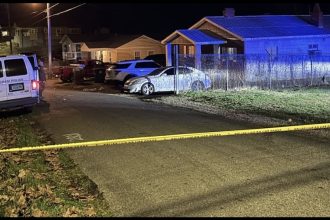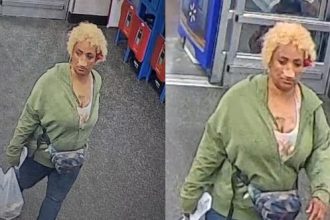Charles Powell Jr. — Resolute Resident, Machete‑Wielding Individual, Relentless in Movement Despite Taser and Warnings, Ultimately Shot by Deputy During Domestic Response on Eighth Street — Community Awaits Answers as Investigation Advances, Family Mourns Profoundly, Neighbors Express Fear, Local Leaders Call for Transparency, and Policy Review Sought Amid Rising Concerns Over Use-of-Force Procedures in Henderson County
A seemingly ordinary evening in the small town of Corydon, nestled within Henderson County, Kentucky, transformed into a scene of intense confrontation and tragic consequence on the 100 block of Eighth Street. At the center of this incident was Charles Powell Jr., a known figure within the community described by those close to him as determined, deeply private, and often reserved. What unfolded on that residential street continues to send shockwaves through the community and has ignited conversations statewide around policing, mental health, and public safety.
According to preliminary information released by the Henderson County Sheriff’s Office, deputies responded to a domestic disturbance call around 7:30 p.m. The nature of the original call has not yet been fully detailed, but sources suggest a concerned neighbor or family member may have reported escalating tensions within the residence.
When law enforcement arrived, they encountered Charles Powell Jr., who was reportedly holding a large machete. The deputy, whose identity has not been publicly released, issued several verbal commands instructing Powell to drop the weapon. Witnesses and initial bodycam footage confirm that Powell did not comply and began advancing toward the deputy in a manner described as determined and deliberate.
In an effort to de-escalate the situation, the deputy deployed a Taser. However, despite the electric shock, Powell remained on his feet and continued to approach, wielding the machete. The footage reportedly captures the deputy repeating commands to stand down as Powell moved closer.
Faced with what authorities have termed a “rapidly evolving threat,” the deputy discharged their firearm. Powell was struck and fell to the ground. Emergency medical services were immediately dispatched, and deputies rendered aid on the scene. Powell was transported to a nearby hospital, where he was later pronounced deceased.
The incident, though only minutes in duration, has left enduring questions in its wake. As the Kentucky State Police take over the investigation—a standard procedure when a law enforcement officer uses force resulting in a fatal outcome—multiple stakeholders are weighing in, demanding transparency and a full account of what transpired.
A Complex Portrait of Charles Powell Jr.
Friends and family of Charles Powell Jr. paint a complicated picture. Known in the neighborhood as a quiet, sometimes reclusive individual, Powell was also deeply committed to his family and often helped his elderly parents with household chores and errands. A graduate of Henderson County High School, Powell reportedly struggled in recent years with mental health issues exacerbated by unemployment and the isolation that followed the COVID-19 pandemic. His family has acknowledged these struggles but insists he posed no ongoing threat to the community.
“He was not a violent man,” said a cousin who asked to remain unnamed. “He was hurting, yes. But he needed help, not bullets.”
Neighbors have expressed varying opinions. Some recall previous police visits to Powell’s residence, describing loud arguments and late-night disturbances. Others insist he was merely misunderstood, a man struggling to find his footing in a community that didn’t always know how to support those battling internal challenges.
Community Reactions and Emotional Reverberations
In the hours and days following the shooting, residents of Corydon gathered at the edge of Eighth Street, where makeshift memorials of candles, flowers, and handwritten notes began to appear. Local pastors led prayer vigils, and civil rights advocates from nearby Owensboro and Evansville called for a broader investigation into the patterns of law enforcement behavior across small towns in the region.
Reactions have been deeply polarized. Some in the community argue that the deputy had no choice and that Powell’s actions left little room for alternatives. Others, particularly advocates focused on mental health and racial equity, question whether sufficient effort was made to de-escalate the situation or whether other community resources might have been better suited to handle the crisis.
“This isn’t just about one man and one officer,” said Latasha Greene, a representative from the Henderson County Accountability Coalition. “It’s about whether the systems we rely on are equipped to respond with care rather than conflict.”
Policy Scrutiny and Institutional Review
In response to the growing calls for transparency, the Henderson County Sheriff’s Office has released a limited statement confirming the incident and stating that all bodycam footage will be reviewed. The Kentucky State Police are currently conducting interviews with witnesses, collecting forensic evidence, and analyzing the events leading up to and following the shooting.
The officer involved has been placed on administrative leave, which is standard procedure during such investigations. There is no current indication of disciplinary action or charges being considered, but officials have stressed that the investigation is ongoing and that all findings will be presented to the Commonwealth Attorney’s Office for review.
County Judge-Executive Brad Schneider and Sheriff Chip Stauffer held a joint press conference, acknowledging the community’s grief and committing to a thorough review of the policies governing use-of-force protocols, especially in domestic and mental health-related calls.
“We must ensure our officers are not only trained in tactical response but also in empathy, mental health assessment, and de-escalation,” said Sheriff Stauffer. “The safety of all our citizens—including those in crisis—depends on it.”
A Broader Context: Policing and Mental Health
This tragic event has added to the growing national debate about how law enforcement agencies respond to individuals experiencing mental health crises. In many rural and underserved communities like Corydon, police are often the first—and sometimes only—responders available during domestic disputes or mental health emergencies.
Advocates have long called for the establishment of co-responder models, in which law enforcement officers are accompanied by trained mental health professionals who can assess and de-escalate situations more effectively. Programs of this kind have shown promise in cities like Denver and Eugene, Oregon, where the CAHOOTS model (Crisis Assistance Helping Out On The Streets) has reduced the number of police-involved fatalities during crisis calls.
As Kentucky grapples with how to adapt such models for its smaller municipalities, the case of Charles Powell Jr. is being cited as a tragic example of what can happen when such support systems are lacking.
Legal and Legislative Ramifications
Civil rights attorneys representing Powell’s family have announced their intention to conduct an independent investigation. At a press conference held outside the Henderson County Courthouse, attorney Raymond Collins stated that “The Powell family deserves to know every detail—not just of Charles’s final moments, but of the policies, practices, and decisions that led to them.”
Collins has also indicated that a civil suit is being considered and that public records requests have been filed seeking internal communications, dispatch logs, and training protocols from the sheriff’s department.
Meanwhile, Kentucky state legislators, including Senator Gerald Neal, have expressed interest in reviewing current statutes governing use-of-force and the availability of mental health crisis responders. A committee hearing may be scheduled in the coming weeks to explore potential reforms, including increased funding for mobile crisis units and mandatory bodycam releases within 48 hours of incidents involving deadly force.
The Ongoing Investigation and What Lies Ahead
At present, key questions remain unanswered: What was the specific nature of the original 911 call? Were there prior warnings or signs that could have prevented the escalation? Was the deployment of a single deputy to a potentially volatile domestic call an appropriate decision? And what alternatives—if any—could have been deployed to preserve both officer safety and civilian life?
Until the full results of the investigation are released, the community remains suspended in uncertainty. The Powell family, supported by friends, activists, and faith leaders, continues to grieve and to press for justice. Meanwhile, the deputy involved and the broader sheriff’s department must navigate the intense scrutiny now focused upon their actions and policies.
In towns like Corydon, where everyone knows each other by name, such incidents leave lasting scars—not only for the families involved but for the officers, neighbors, and institutions that must find a path forward through grief, accountability, and healing.
As the candlelight vigils continue to flicker on Eighth Street, a community quietly demands more than just answers. It demands change.




